For 3,000 years, a series of roads connected the East with the West. Long, treacherous and, in some places, nearly impassable, some eight or nine roads for centuries offered the only access between China, India and Europe. These together have come to be known as the Silk Road.
Extending almost 6,000 miles from end to end, the roads were traveled by spice and slave traders, spiritual pilgrims and silk merchants. They crossed mountains, deserts and grasslands. Spiritual sojourners from India and South Asia brought the teachings of Buddha to the Far East, leaving in their wake a series of sacred sights and long-forgotten texts. Great cities were built and perished along the road and, even today, its routes are followed by modern highways and rail lines.
The Silk Road takes a northerly course through China, starting from the city of Xi’an and heading northwest, through Gansu and Xinjiang Provinces. Trains and highways provide transport to the area, though it is still one of the most remote and untouched places on earth.
Terracotta Warrior Army
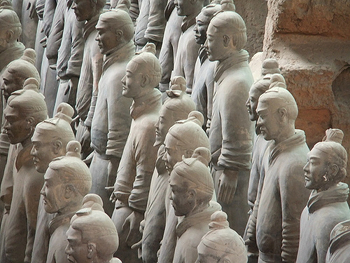 Standing before this massive army of thousands of terracotta horses and soldiers is truly gasp-worthy. One of the country’s main attractions, the first emperor of China, Qin Shi Huang, had the army built in 210 B.C. to carry him safely into the afterlife. The figures were discovered in 1974 and deemed a UNESCO World Heritage Site in 1987. The soldiers, chariots and horses have been preserved in their original forms, standing in long rows that are now covered by protective structures. Three archaeological pits full of figures are currently open to visitors at the site.
Standing before this massive army of thousands of terracotta horses and soldiers is truly gasp-worthy. One of the country’s main attractions, the first emperor of China, Qin Shi Huang, had the army built in 210 B.C. to carry him safely into the afterlife. The figures were discovered in 1974 and deemed a UNESCO World Heritage Site in 1987. The soldiers, chariots and horses have been preserved in their original forms, standing in long rows that are now covered by protective structures. Three archaeological pits full of figures are currently open to visitors at the site.
Jiayuguan Fort
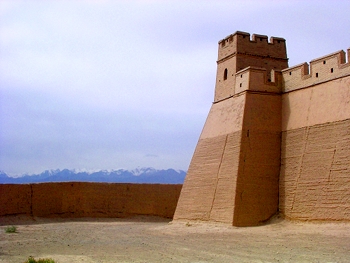 Standing tall in the desert of Gansu Province, this magnificent mud fortress punctuates the end of the Great Wall of China. With a name meaning “excellent valley pass,” the fortress at Jiayuguan was the last outpost of China’s ancient empire. Traitors were sometimes banished through its gates and out into the vast desert, never to be heard from again. The square fortress has been well restored, and visitors can climb up onto the towers and along the walls, which offer an amazing view of the open desert, the mud-built unrestored sections of the Great Wall, and Qilian Mountains to the south. Nearby, a dusty but informative museum offers a history of the Great Wall.
Standing tall in the desert of Gansu Province, this magnificent mud fortress punctuates the end of the Great Wall of China. With a name meaning “excellent valley pass,” the fortress at Jiayuguan was the last outpost of China’s ancient empire. Traitors were sometimes banished through its gates and out into the vast desert, never to be heard from again. The square fortress has been well restored, and visitors can climb up onto the towers and along the walls, which offer an amazing view of the open desert, the mud-built unrestored sections of the Great Wall, and Qilian Mountains to the south. Nearby, a dusty but informative museum offers a history of the Great Wall.
Mogao Caves
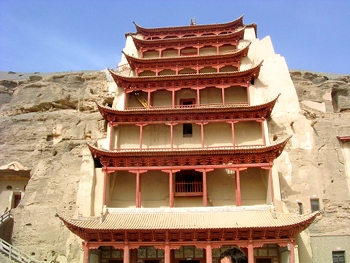 Further west near Dunhuang, these spectacular grottoes are among the best preserved remnants of spiritual sojourners on the Silk Road. Dating to 366 A.D., the “Caves of the Thousand Buddhas,” as they are often called, were built by the monk Le Zun according to a vision he had. 487 caves exist on the site, some of them adorned with spiritual wall paintings. Many of the original texts discovered here were taken by British archaeologists. The caves are only opened on guided tours and are unlit to preserve the interior decorations, so a flashlight is recommended if you visit.
Further west near Dunhuang, these spectacular grottoes are among the best preserved remnants of spiritual sojourners on the Silk Road. Dating to 366 A.D., the “Caves of the Thousand Buddhas,” as they are often called, were built by the monk Le Zun according to a vision he had. 487 caves exist on the site, some of them adorned with spiritual wall paintings. Many of the original texts discovered here were taken by British archaeologists. The caves are only opened on guided tours and are unlit to preserve the interior decorations, so a flashlight is recommended if you visit.
Mingsha Dune
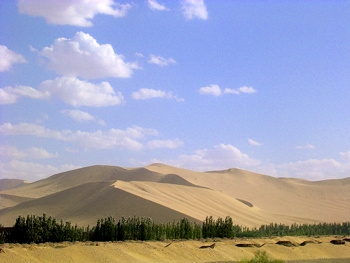 The dusty little town of Dunhuang lies on the edge of the Taklamakan Desert and has the sand dunes to prove it. A city of less than 200,000 people, sleepy Dunhuang is home to the Mingsha Dune. Translated as “singing sand,” the dune gets its name from the whistling noise made by sand whipping in the wind. At the bottom of the dune, a natural oasis with a pond has existed for thousands of years, thanks largely to wind patterns here leaving it untouched by sand. Mingsha Dune park and the oasis are open to visitors, and stairs ease the sandy trek to the top, where you can try out sand sledding.
The dusty little town of Dunhuang lies on the edge of the Taklamakan Desert and has the sand dunes to prove it. A city of less than 200,000 people, sleepy Dunhuang is home to the Mingsha Dune. Translated as “singing sand,” the dune gets its name from the whistling noise made by sand whipping in the wind. At the bottom of the dune, a natural oasis with a pond has existed for thousands of years, thanks largely to wind patterns here leaving it untouched by sand. Mingsha Dune park and the oasis are open to visitors, and stairs ease the sandy trek to the top, where you can try out sand sledding.
Jiaohe Ancient City
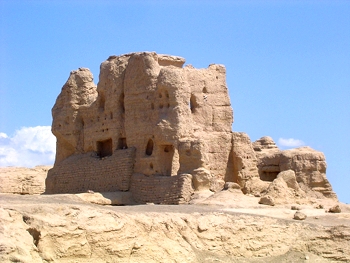 Up until the 13th century, Jiaohe was a thriving city and prefectural capital not far from Turpan in Xinjiang Province. This ancient town was a key stop along the Silk Road and a spiritual epicenter with numerous stupas and temples. Most of the buildings were made from mud bricks, but after the Mongols, led by Genghis Khan, invaded and decimated the area in the 1200s, the entire city was abandoned. The ruins of this extensive city have been partially excavated to reveal dozens of homes, government buildings and graveyards.
Up until the 13th century, Jiaohe was a thriving city and prefectural capital not far from Turpan in Xinjiang Province. This ancient town was a key stop along the Silk Road and a spiritual epicenter with numerous stupas and temples. Most of the buildings were made from mud bricks, but after the Mongols, led by Genghis Khan, invaded and decimated the area in the 1200s, the entire city was abandoned. The ruins of this extensive city have been partially excavated to reveal dozens of homes, government buildings and graveyards.
Turpan Vineyards
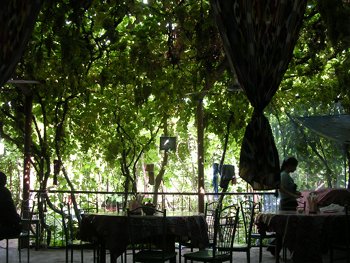 Settled in a dusty nook of Xinjiang Province is the oasis of Turpan, an ancient Turkik kingdom and an important stop along the Silk Road. Turpan is known for several things: its Islamic minaret, its largely Uyghur culture, its arid climate. But what most distinguishes Turpan is the Grape Valley, known in Chinese as putaogou. A series of irrigation ditches provide water to the otherwise parched landscape, dotting it with layers of green vines. Most of China’s admittedly meager wine stock comes from this area, and several restaurants offer open-air dining. Here, local wine and food are served under grape-laden trellises, while canals babble gently nearby, transporting you from China into the depths of Central Asia in an instant.
Settled in a dusty nook of Xinjiang Province is the oasis of Turpan, an ancient Turkik kingdom and an important stop along the Silk Road. Turpan is known for several things: its Islamic minaret, its largely Uyghur culture, its arid climate. But what most distinguishes Turpan is the Grape Valley, known in Chinese as putaogou. A series of irrigation ditches provide water to the otherwise parched landscape, dotting it with layers of green vines. Most of China’s admittedly meager wine stock comes from this area, and several restaurants offer open-air dining. Here, local wine and food are served under grape-laden trellises, while canals babble gently nearby, transporting you from China into the depths of Central Asia in an instant.
The Flaming Mountains
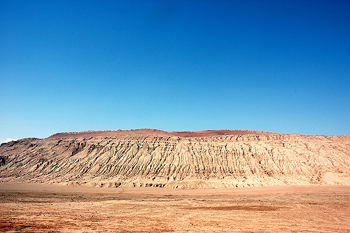 If you manage to view these limestone hills at the right time of day, you will see exactly where their name comes from. Long trenches and cracks (created from millenia-old lava erosion) scour the brown and red hillsides, creating the illusion of flames when the sun hits right. Located in the depths of the Taklamakan Desert, the mountains run for about 60 kilometers through rugged, barren terrain. They are accessible by jeep either from Dunhuang or Turpan, but guides refuse to go during the sandstorms that frequently vex the area.
If you manage to view these limestone hills at the right time of day, you will see exactly where their name comes from. Long trenches and cracks (created from millenia-old lava erosion) scour the brown and red hillsides, creating the illusion of flames when the sun hits right. Located in the depths of the Taklamakan Desert, the mountains run for about 60 kilometers through rugged, barren terrain. They are accessible by jeep either from Dunhuang or Turpan, but guides refuse to go during the sandstorms that frequently vex the area.
Labrang Monastery
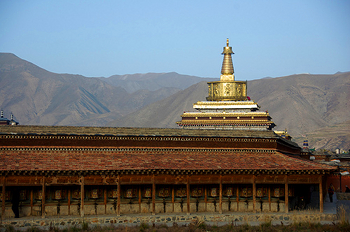 Founded in 1709, Labrang Monastery is one of the largest monasteries in China and is considered to be one of the six most influential Geluk Tibetan Buddhist temples. During its golden period at the beginning of the 20th century, Labrang was a massive, thriving university, home to some 2,000 monks. The complex consists of 18 different halls built around the golden stupa, whose spire is visible even from outside the complex walls. The monastery is located in Xiahe, Gansu Province, a few hours from Lanzhou.
Founded in 1709, Labrang Monastery is one of the largest monasteries in China and is considered to be one of the six most influential Geluk Tibetan Buddhist temples. During its golden period at the beginning of the 20th century, Labrang was a massive, thriving university, home to some 2,000 monks. The complex consists of 18 different halls built around the golden stupa, whose spire is visible even from outside the complex walls. The monastery is located in Xiahe, Gansu Province, a few hours from Lanzhou.
Tianchi Lake
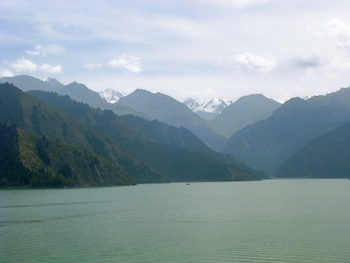 With a befitting name that means “heavenly lake,” Tianchi is located at a celestial altitude, 6,600 feet above sea level. It is settled in among the Tian Shan (again, “heavenly”) Mountains, east of Urumqi. The snowy crags of Jengish Chokusu (Bogda Shan in Chinese), the highest peak in the range, reflect in the waters of the lake year-round. A few ethnic Kazakh families still live in yurt tents near the lake, making their living herding goats and yaks. Most visitors to the lake take advantage of a few constructed walking paths, and the serenity of the lake is occasionally undermined by the honking of scenic boats that zip tourists (mostly Han Chinese) from shore to shore.
With a befitting name that means “heavenly lake,” Tianchi is located at a celestial altitude, 6,600 feet above sea level. It is settled in among the Tian Shan (again, “heavenly”) Mountains, east of Urumqi. The snowy crags of Jengish Chokusu (Bogda Shan in Chinese), the highest peak in the range, reflect in the waters of the lake year-round. A few ethnic Kazakh families still live in yurt tents near the lake, making their living herding goats and yaks. Most visitors to the lake take advantage of a few constructed walking paths, and the serenity of the lake is occasionally undermined by the honking of scenic boats that zip tourists (mostly Han Chinese) from shore to shore.
Kashgar Sunday Market
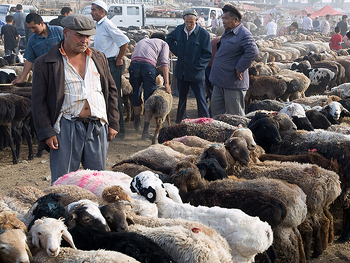 Marking the western end of China’s Silk Road is the oasis city of Kashgar, home to some of the most well preserved Islamic architecture in China. This dynamic place is much more Central Asian than Chinese, with a dominant population of Kazakhs and Muslim Uyghers that lead largely pastoral lifestyles. Evidence of this is the incredibly busy Sunday market, where you can buy everything from a silk scarf to a sheep. Livestock is a huge trade here, with farmers selling horses, cows, goats and donkeys to discerning buyers. The best part of going to the Kashgar market is simply soaking up the atmosphere — the strange and sometimes intense smells, the clattering of hooves and the occasional dust bunny stinging at your eyes. If you feel the need to purchase, go for the hats: There are more of these than anything else and they come in all shapes and sizes — big, small, furry, feathery, some with ear flaps and even some old Communist “Mao” style hats. Pick your pleasure.
Marking the western end of China’s Silk Road is the oasis city of Kashgar, home to some of the most well preserved Islamic architecture in China. This dynamic place is much more Central Asian than Chinese, with a dominant population of Kazakhs and Muslim Uyghers that lead largely pastoral lifestyles. Evidence of this is the incredibly busy Sunday market, where you can buy everything from a silk scarf to a sheep. Livestock is a huge trade here, with farmers selling horses, cows, goats and donkeys to discerning buyers. The best part of going to the Kashgar market is simply soaking up the atmosphere — the strange and sometimes intense smells, the clattering of hooves and the occasional dust bunny stinging at your eyes. If you feel the need to purchase, go for the hats: There are more of these than anything else and they come in all shapes and sizes — big, small, furry, feathery, some with ear flaps and even some old Communist “Mao” style hats. Pick your pleasure.

